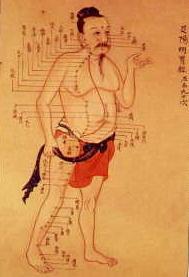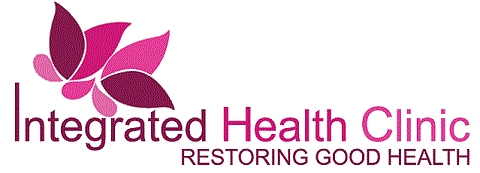Acupuncture originates from ancient Traditional Chinese Medicine (TCM)  almost 3,000 yrs ago. It involves the insertion of fine needles into the skin and underlying tissue. The points at which they are inserted correspond to acupuncture points. The fundamental concept of acupuncture is based on balancing the body ‘Qi’ (pronounced ‘chee’) pertaining to body ‘Energy’. Qi is described as circulating around the body in 12 major meridians (or channels), supported by 8 extra meridians, 15 collaterals and others. The meridians pathways travel in the limbs, trunk, head and neck. In the case of physical or mental illness there is a disturbance in its flow. Acupuncture believes that the body has the ability to heal itself by correcting any imbalances in the Qi. This done by implementing the theory of Yin and Yang balance, Five Element Theory and the Eight diagnostic criteria within its treatment approach. Acupuncture is a safe CAM treatment, with few side effects when practiced by a qualified professional. Minor after effects may include drowsiness, bleeding or bruising around the needle site.
almost 3,000 yrs ago. It involves the insertion of fine needles into the skin and underlying tissue. The points at which they are inserted correspond to acupuncture points. The fundamental concept of acupuncture is based on balancing the body ‘Qi’ (pronounced ‘chee’) pertaining to body ‘Energy’. Qi is described as circulating around the body in 12 major meridians (or channels), supported by 8 extra meridians, 15 collaterals and others. The meridians pathways travel in the limbs, trunk, head and neck. In the case of physical or mental illness there is a disturbance in its flow. Acupuncture believes that the body has the ability to heal itself by correcting any imbalances in the Qi. This done by implementing the theory of Yin and Yang balance, Five Element Theory and the Eight diagnostic criteria within its treatment approach. Acupuncture is a safe CAM treatment, with few side effects when practiced by a qualified professional. Minor after effects may include drowsiness, bleeding or bruising around the needle site.
TCM Acupuncture can be used in a variety of conditions including pain symptoms. In addition to acupuncture practitioners may use moxa (a herbal heat treatment), cupping treatment both part of the TCM system of medicine. Moxa helps to stimulate the Qi energies while cupping cupping enhances blood and lymphatic flow, as well as nerve function. Combined with massage it helps to reduce muscular and tissue tightness, and adhesions by lifting and loosening the skin and muscles. It is particularly useful for tight back or frozen shoulders.
Western medical acupuncture (also known as Dry Needling) is an adaptation of TCM acupuncture and mainly used for the treatment of pain. Many physiotherapists, osteopaths or chiropractors have now incorporated it into their treatments . It uses the modern medicine concepts of the ‘Gate control theory of pain’, which is based on the understanding that the acupuncture needling changes the perception of pain through the interaction of different neurons.
What happens during a therapy session?
During a session you will usually be asked to lie down on a treatment couch. You will remain fully clothed and will be asked to roll up your sleeves or trousers exposing only relevant treatment areas. The practitioner will start by assessing your health status and a diagnostic process. This may include examination of the pulse, tongue and other general appearance, and examination of the problem areas. Fine single-use sterile needs are inserted into relevant parts of the body. These are normally single use and then disposed of, thus removing the risk of cross infection. Other than the initial sting at insertion once the needles are in there should be no pain. These needles may be left for about 20-30 min and then removed. In some cases practitioners may use moxa (a small spongy herb also known as mugwort) or electro-acupuncture to enhance the healing process. Each session lasts around 40-60 min long.
How can Acupuncture help ?
TCM Acupuncture is generally beneficial for most health conditions, including musculo-skeletal pain, inflammation, arthritis, back pain, stroke, PMT, fatigue, stress, anxiety, depression, allergy, IBS and overall well-being. Acupuncture is believed to stimulate the circulatory and nervous system causing the release of neuro-chemicals (serotonin and endorphins) that influence biochemical changes within the body’s homeostatic mechanisms, thus promoting physical and emotional wellbeing.
- Release body chemicals and changes the way the brain and spinal cord processes the pain signals. These chemicals include; endorphins and other neurohumoral factors e.g. neuropeptide Y, serotonin.
- Increases local release of nitrous oxide (NO) known to play an important physiological role in skin local microcirculation, neurotransmission, immunity and wound healing.
- Increases the release of adenosine, which reduces the sensitivity to pain
- Modulates parts of the brain network (limbic and paralimbic system), responsible for anti-pain, anti-anxiety, and other therapeutic effects
- Reduces inflammation by releasing factors responsible for vascular and immune system regulation.
- Improves muscle stiffness and joint mobility by increasing local microcirculation, and therefore resolution of swelling.
- Benefits depression by acting through other pathways involving dopamine, noradrenaline, cortisol and neuropeptide Y. Stress-induced behavioural and biochemical changes may also be reversed.Acupuncture can generally be safely used in combination with medical treatments.
Read more about mechanism and applications of acupuncture below;
- Acupuncture: How does it work ?
- Cabyoglu MT, Ergene N. The mechanism of acupuncture and clinical applications. Intern. J. Neuroscience, 2006; 116: 115-125.
Revised: Aug 2017
